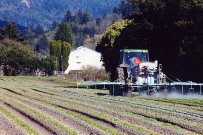A Near Doubling of “Bad Actor” Pesticide Use on Lily Fields Surrounding the Smith River Estuary
A recent confluence of local events begs important questions about the epidemiological consequences of environmental toxins, and efforts to “fight cancer.”
In January the California Department of Pesticide Regulation released its annual “Pesticide Use Report” for California counties. The most recent data (for 2008; DPR is always one year late with the reports) show a large increase in the use of highly toxic pesticides on lily fields surrounding the estuary of the Smith River, and the town of the same name, in Del Norte County. Below is a list of some of these chemicals, their harmful effects, and the amount used in Smith River.
At around the same time an elementary school student presented me with a little cardboard box seeking donations of change and asking donors to “think BIG to cure leukemia.”
These events are not unconnected.
The coin box looked as if it might hold a Happy Meal or a disposable camera. It was colorful and adorned with pennies, one held up by an attractive young woman, probably of high school age, who looks healthy enough — assuredly no one would want her to contract cancer. And if she did we’d want her to receive the best medical treatment available.
The girl on the “Think Big” box reminded me of a high school student I met ten years ago in the town of Smith River. The girl had been diagnosed with leukemia, one of at least three young leukemia victims in the tiny town at that time, an inordinately high number. How could so many leukemia patients exist in a population of 2,000 people situated alongside the banks of one of the world’s cleanest rivers, in a region that enjoys some of the world’s best air quality?
The answer may lie in a field of flowers. Farmers in Smith River grow 90 percent of the world’s supply of Easter lily bulbs. To protect their crops they apply large amounts of pesticides. Several of these pesticides are known or probable carcinogens and groundwater contaminants.

A ditch collects toxic chemicals from lily bulb greenhouses and runs to the Smith River Estuary. Photo by Greg King.
A decade ago I served as executive director of the Smith River Project, a non-profit organization dedicated to protecting one of the wildest and cleanest watersheds on Earth. As such, we concentrated on reducing pesticide use at the mouth of the Smith River. We conducted free water testing on residents’ wells and found widespread and dangerous levels of contamination by the chemical 1,2-Dichloropropane. This acute carcinogen was phased out during the 1980s, at about the same time that Smith River turned up some of the highest 1,2-D contamination levels in the nation. The wells were still tainted 15 years later, and they, and air quality, were threatened by continued immense applications of other groundwater contaminants and carcinogens.
Siskiyou Land Conservancy supports farms and farmers, including lily farmers. Growing lilies commercially is not easy. Fungi and nematodes attack the plants and can turn a large monetary investment, and a lot of work, into a significant loss. Lily farmers have spend decades researching alternatives to pesticides, but apparently without success. Recent use of the most toxic pesticides in Smith River has escalated dramatically. Ten years ago the Smith River Project produced a list of “Eight Bad Actors,” tracking the most highly acute pesticides used on lily farms in the region. Following is that list, with amounts (in pounds) listed for 2000 and 2008, and its effects on humans and the environment.
Thankfully, use of some of the Eight Bad Actors has diminished on the Smith River Plain; one particularly nasty fungicide, Pentachloronitrobenzene, which was first widely synthesized in the 1930s by the Nazi German chemical manufacturer I.G. Farben, has been eliminated altogether. (PCNB was phased out over several years after a nationwide ban went into effect in 1989.)
That said, overall pesticide use in Del Norte County increased from 275,095 pounds in 2000 to 321,641 pounds 2008, a highly discouraging jump of 17 percent. Application of the Eight Bad Actors on lily fields surrounding the Smith River estuary, and affecting residents in the town of Smith River, jumped from 151,271 pounds in 2000 to 278,428 pounds in 2008, an increase of 84 percent.
In addition, bulb growers are now using the highly toxic carcinogen and groundwater contaminant Ethoprop (1,534 pounds in 2008), which was not used in 2000. Likewise, growers in 2008 used 517 pounds of Maneb, a carcinogen and reproductive toxin that saw only 18 pounds of use in 2000.
In the list below, the first chemical, 1,3-Dichloropropene, has been used as a replacement for 1,2-D as a nematicide for the bulb fields. While there is now little doubt that 1,3-D causes cancer, use of the chemical has more than doubled in Smith River in less than a decade. Use of the disturbingly toxic chemical Metam Sodium has also more than doubled on the Smith River Plain. Not only are these chemicals dangerous to humans, they can be lethal to aquatic organisms, including fish — a bitter reality given the chemical saturation that occurs at the mouth of California’s healthiest anadromous fish stream, whose salmon and steelhead populations are in decline.

A sign in Smith River warns against entering a lily field recently sprayed with 1,3-D. Photo by Greg King.
So when the student presented me with her box for coins to cure leukemia I indeed chipped in — anyone with cancer, particularly a child, deserves treatment. But the place to first fight cancer is at the cause.
Greg King
President/Program Director
Siskiyou Land Conservancy
1) 1,3-Dichloropropene (Telone II)
USE: nematicide, soil fumigant
AMOUNT USED (2000): 55,000 pounds
AMOUNT USED (2008): 126,596 pounds
TOXICOLOGICAL EFFECTS: Exposure can lead to chest pains, irritation of the respiratory tract, coughing, and rashes. Single doses can cause lung damage and the kidneys are particularly sensitive Most typical exposure is via inhalation, though ingesting it is most toxic.
CLASS: Probable human carcinogen & probable reproductive toxin.
ENVIRONMENTAL FATE: Highly soluble in water and does not evaporate readily. Telone II is likely to contaminate groundwater. Aquatic organisms can be killed by concentrations of less than 10 parts per million.
2) Chloropicrin
USE: fungicide, soil fumigant
AMOUNT USED (2000): 9,806 pounds
AMOUNT USED (2008): 812 pounds
TOXICOLOGICAL EFFECTS: Highly toxic by all routes: oral, dermal, and inhalation.
Inhalation can cause injury to the respiratory tract, vomiting, and possibly death.
ENVIRONMENTAL FATE: Highly toxic to fish, breaks down quickly in the environment.
3) Metam Sodium
USE: soil fumigant, nematicide
AMOUNT USED (2000): 62,493 pounds
AMOUNT USED (2008): 141,086 pounds
TOXICOLOGICAL EFFECTS: Skin irritation, eye irritation, nervous system damage.
Can cause allergies via sensitization, primary breakdown product is MITC (methylisothiocyanate) which can induce asthma.
CLASS: reproductive toxic, immune system toxicant, and probable human carcinogen.
ENVIRONMENTAL FATE: Highly toxic to fish—
Breakdown to MITC, 1 part per trillion caused 100 % mortality in tadpoles.
4) Chlorothalonil
USE: fungicide
AMOUNT USED (2000): 14,300 pounds
AMOUNT USED (2008): 4,942 pounds
TOXICOLOGICAL EFFECTS: Inhalation has the greatest toxicity, irritating to the eyes and skin, people working with it can become sensitized and form allergic rashes and swelling.
CLASS: probable human carcinogen, reproductive toxin
ENVIRONMENTAL FATE: This chemical can contaminate the air traveling beyond the field and has been found in nearby residential neighborhoods. It is persistent in soils and acutely toxic to fish, crab, frogs, and water fleas.
5) Carbofuran
USE: carbamate nematicide, soil fumigant.
AMOUNT USED (2000): 1,000 pounds
AMOUNT USED (2008): 738 pounds
TOXICOLOGICAL EFFECTS: Carbofuran is highly toxic by inhalation and ingestion.
It can cause nausea, vomiting, blurred vision, increased blood pressure, and sweating.
CLASS: Reproductive toxin.
ENVIRONMENTAL FATE: Highly toxic to fish and raptors, high potential for groundwater contamination and is very mobile in soil
6) Diuron
USE: herbicide
AMOUNT USED (2000): 1,809 pounds
AMOUNT USED (2008): 1,580 pounds
TOXICOLOGICAL EFFECTS: This chemical is slightly toxic by all routes.
CLASS: At high doses Diuron can cause birth defects.
ENVIRONMENTAL FATE: This chemical is highly persistent in soils and can contaminate groundwater. It is highly toxic to aquatic invertebrates.
7) Disulfoton
USE: Organophosphate insecticide
AMOUNT USED (2000): 3,232 pounds
AMOUNT USED (2008): 2,674 pounds
TOXICOLOGICAL EFFECTS: Highly toxic by all routes of exposure. Exposure can cause blurred vision, fatigue, nervous system affects, convulsions, and coma.
ENVIRONMENTAL FATE: This chemical is highly toxic to fish and is persistent and mobile enough in water that it is likely to contaminate groundwater.
8) Pentachloronitrobenzene (PCNB)
USE: Fungicide
AMOUNT USED (2000): 3,631 pounds
AMOUNT USED (2008): 0 pounds
TOXICOLOGICAL EFFECTS: Slightly toxic via oral and inhalation routes. Can cause sensitized rashes, dizziness, and lethargy. Can cause birth defects (cleft palates and missing kidneys) because it is contaminated with hexachlorbenzene.
ENVIRNMENTAL FATE: Highly toxic to fish. Persistent and can contaminate groundwater. May bioaccumulate in the ecosystem.


